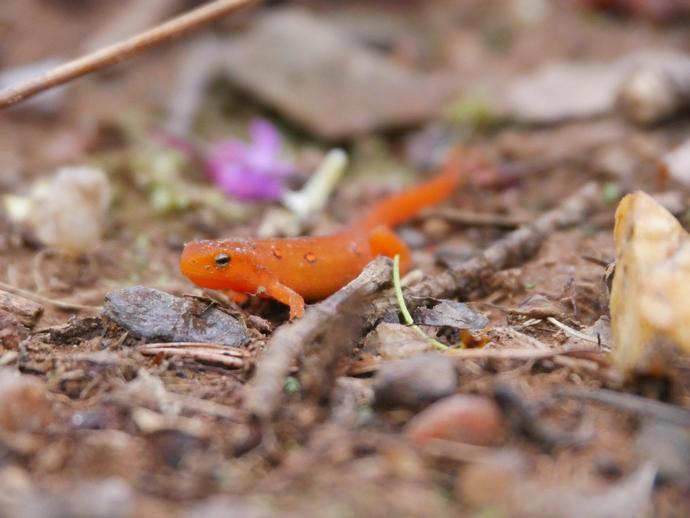December 5, 2020
We're reaching into the archives for today's #BenInNature update! The following post was originally published on April 21, 2020.
The eastern newt Notophthalmus viridescens is fairly common, but its life cycle is anything but. These newts start their lives as brownish-green aquatic larvae with gills. After about three months, they turn bright reddish-orange, emerge onto land, and shed their gills. During this terrestrial stage of life, they are known as "red efts" (the two pictured eastern newts are both red efts). During this time, red efts will wander as far as their tiny legs can carry them as they seek out a new pond to call home. After two or three years, when the eft finds a new pond, its bright colors begin to fade back to a dull olive. It grows a wide, paddle-like tail, slips into its new pond, and becomes an aquatic adult.
So why the bright orange coloration during the eft stage? Eastern newts carry a potent sodium channel blocking neurotoxin known as tetrodotoxin. Several other animals carry this same neurotoxin, such as pufferfish and blue-ringed octopi. The bright coloration of the red eft is an example of aposematism (warning colors) that let predators know they would be better off finding lunch somewhere else.
While eastern newts can be spotted pretty frequently, like many amphibians, they are under threat from a variety of dangers, such as climate change, emergent diseases, invasive species and habitat fragmentation, just to name a few. So if you see a red eft strolling through your yard, leave it be to continue its journey.
ABOUT #BenInNature
Social distancing can be difficult, but it presents a great opportunity to become reacquainted with nature. In this series of posts, Administrator of Science Ben Williams ventures outdoors to record a snapshot of the unique sights that can be found in the natural world. New updates are posted Monday - Friday, with previous posts highlighted on the weekends.
NEW: TRIVIA CHALLENGE
You've seen the posts. You've learned the facts. Now, it's time to prove you are a #BenInNature Mega Fan! The museum's education team has developed the #BenInNature Trivia Challenge to identify the most devoted fans out there! Everyone who successfully answers each trivia question correctly will be congratulated by having your own nature selfie posted to the museum's #BenInNature Mega Fan Photo Album on the official VMNH Facebook page! Learn more and download the trivia challenge today by visiting www.vmnh.net/research-collections/beninnature-trivia-challenge.
NATURE PHOTO IDENTIFICATIONS
If you discover something in nature that you would like help identifying, be sure to message us right here on Facebook with a picture (please include location and date of picture) and we'll have our experts help you identify it!

 Hours & Admissions
Hours & Admissions Directions
Directions

